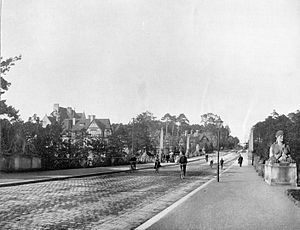Bismarck Bridge (Berlin)
Coordinates: 52 ° 29 ′ 14 " N , 13 ° 16 ′ 38" E
| Bismarck Bridge | ||
|---|---|---|
| Bismarck Bridge around 1900 | ||
| use | Road traffic, pedestrians | |
| Convicted | Grunewaldseenkette (side channel) | |
| place | Berlin-Grunewald | |
| completion | 1891 | |
| location | ||
|
|
||
The Bismarck Bridge in Berlin-Grunewald serves as a crossing of a channel between Herthasee and Hubertussee . It is named after Chancellor Otto von Bismarck . The listed bridge was built in 1891 . It is located near Bismarckplatz .
Construction
The Bismarck Bridge is built as a steel beam structure supported by neo-baroque brick arches.
layout
The design of the Bismarck Bridge was taken over by the sculptor Max Klein . The bridgeheads are flanked by four sphinxes that lie on stone pedestals. The figures are made of sandstone . In addition, four obelisks and neo-baroque vases are attached to the parapet of the bridge .
history
The bridge and the sculptures survived the Second World War without major damage.
gallery
Web links
Commons : Bismarck Bridge - collection of images, videos and audio files
- The sphinxes on the Bismarck Bridge, berlin.de.
- Bismarckbrücke on berlin.de , accessed on July 25, 2019
Individual evidence
- ↑ Bismarckbrücke on berlin.de , accessed on July 25, 2019.
- ↑ Landesdenkmalamt Berlin , accessed on July 27, 2019
- ↑ The Sphinxes on the Bismarck Bridge, berlin.de. Retrieved July 25, 2019.




